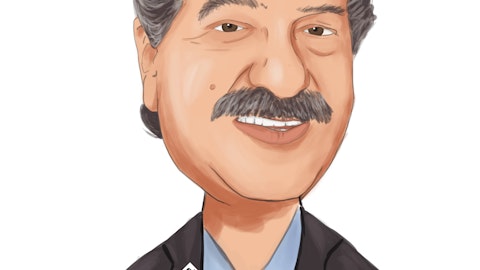Sify Technologies Limited (NASDAQ:SIFY) Q3 2023 Earnings Call Transcript January 25, 2023
Operator: Good morning, and welcome to Sify Technologies Financial Results for Third Quarter and Fiscal Year 2022 to 2023. . Please note, this conference is being recorded. I will now turn the conference over to your host, Mr. Praveen Krishna. Praveen, the floor is yours.
Praveen Krishna: Thank you, Jenny. I would like to extend a warm welcome to all our participants on behalf of Sify Technologies Limited. I’m joined on the call today by Raju Vegesna, our Chairman; M. P. Vijay Kumar, Executive Director and Group CFO; and Kamal Nath, CEO. Following our comments on the results, there will be an opportunity for questions. If you do not have a copy of our press release, please call Grayling Global at 646-284-9400, and we’ll have one sent to you. Alternatively, you may obtain a copy of the release at the Investor Information section on the company’s corporate website at www.sifytechnologies.com/investors. A replay of today’s call may be accessed by dialing in on the numbers provided in the press release or by accessing the webcast in the Investor Information section of the Sify corporate website.
Some of the financial measures referred to during this call and in the earnings release may include non-GAAP measures. Sify’s results for the year are according to the International Financial Reporting Standards or IFRS, and will differ somewhat from the GAAP announcements made in previous years. A presentation of the most directly comparable financial measures calculated and presented in accordance with GAAP and a reconciliation of such non-GAAP measures and of the differences between such non-GAAP measures and the most comparable financial measures calculated and presented in accordance with GAAP will be made available on Sify’s website. Before we continue, I would like to point out that certain statements contained in the earnings release and on this conference call are forward-looking statements rather than historical facts and are subject to risks and uncertainties that could cause actual results to differ materially from those described.

Photo by Jordan Harrison on Unsplash
With respect to such forward-looking statements, the company sees protection afforded by the Private Securities Litigation Reform Act of 1995. These risks include a variety of factors, including competitive developments and risk factors listed from time to time in the company’s SEC reports and public releases. Those lists are intended to identify certain principal factors that could cause actual results to differ materially from those described in the forward-looking statements, but are not intended to a complete list of all risks and uncertainties inherent to the company’s business. Let me now introduce Mr. Raju Vegesna, Chairman of Sify Technologies. Chairman?
Raju Vegesna: Thank you, Praveen. Good morning, everyone, and thank you for joining us on the call. India’s resilience demonstrated post-COVID has formally established, it has an economy that is not easily disturbed by changes in the business enrollment. This is with an aggressive adoption of digital tools, has worked well for the economy. The government’s larger agenda of ensuring that social measures reach the intended beneficiaries is a work in progress, and we’ll continue to drive the domestic IT demand. International demand is expected to continue due to the comparable attractiveness of the Indian market in spite of the tightening world economy. And you together, this worked well for an economy that is still at the early stages of realizing its potential. Let me now bring in Kamal, our CEO, to expand on some of the business highlights for the past quarter. Kamal?
Kamal Nath: Yes. Thank you, Raju. Indian enterprises have fast-tracked their digital initiatives based on their success and navigating the pandemic and are now operationalizing pandemic era innovations. Enterprise priorities are building business aligned digital models, enhancing end-user experience, deploying resilient business continuity models and mitigating security risks. Our Data Center and Cloud Services, Digital and Network Services are all important building blocks to enable customers’ business priorities. And we expect each of the businesses to grow with the related investments. Let me now expand on the business balance for the quarter. Revenue from Data Center Services grew approximately 19% over same quarter last year.
Revenue from Digital Services grew approximately 90% over the same quarter last year. Revenue from Network Services grew by 8% over same quarter last year. The revenue split between the businesses for the quarter was Data Center Colocation Services at 27%; Digital Services at 35% and Network Services at 38%. Sify commissioned incremental data center capacity of 4.1 megawatt in the quarter. As on December 31, 2022, Sify provides services via 846 fiber nodes across the country, an 11% increase over the same quarter last year. The network connectivity service has now deployed 5,900 — service bonds across the country. During the quarter, Sify has invested in start-ups in the — U.S. dollars in the Silicon Valley area as part of our corporate venture capital initiative.
To date, the cumulative investment stands at USD 4.69 million. A detailed list of our key wins is recorded in our press release, now live on our website. Let me bring in Vijay, our Executive Director and our Group CFO, to elaborate on the financial highlights for the quarter. Vijay?
M. P. Vijay Kumar: Thank you, Kamal. Good morning, everyone. Let me briefly sum up the financial performance for the third quarter of financial year 2022, ’23. Revenue was million, an increase of 31% over the same quarter last year. EBITDA was INR 1,619 million, an increase of 3% over the same quarter last year. Profit before tax was INR 227 million, a decrease of 52% over the same quarter last year. Profit after tax was INR 258 million, a decrease of 25% over the same quarter last year. The profit after tax is higher than the PBT, profit before tax due to recognition of a deferred tax asset. Capital expenditure during the quarter was million. Our investment into the Data Center side of the business continues with incoming demand from both retail and hyperscale customers.
We have scaled up investments, both capital expenditure and operating expenditure in our fiber network in select metro cities to scale our network business and in people for our Digital Services business. Network connectivity, cloud interconnect and resultant investment in tools, processes, people will augment this demand. Fiscal discipline will be of constant, particularly in our investment process. Cash balance at the end of the quarter was INR 4,256 million. I will now hand over to our Chairman for his closing remarks.
Raju Vegesna: Thank you, Vijay. Enterprises now view digital adoption as a business imperative. Based on the size of their investment and ambitions, it will require continuous engagement with service providers like us. Our aim is to become a constant in their considerable bracket — in their consideration bracket. Thank you for joining us on this call. I will now hand over to the operator for questions. Operator?
See also 15 Most Undervalued NASDAQ Stocks and 12 Cheap Bank Stocks To Buy.
Q&A Session
Follow Sify Technologies Ltd (NASDAQ:SIFY)
Follow Sify Technologies Ltd (NASDAQ:SIFY)
Receive real-time insider trading and news alerts
Operator: . Your first question is coming from Greg Burns, Sidoti & Company.
Greg Burns: The EBITDA margin came in a little bit below what I was expecting. I think some of that’s due to mix, but was there anything outside of the higher mix of digital services that led to the lower margin?
M. P. Vijay Kumar: You’re right. There is — it is essentially due to our investments into people cost for our digital services business. And as I mentioned, it is also due to operating expenses, investment in our network fiber expansion in select metro cities.
Greg Burns: Okay. Do you see the margin contracting further from here? Or are you going to start to get some leverage on these investments, I guess, when will you start to see the revenue from these investments offsetting some of the incremental spend?
M. P. Vijay Kumar: Correct. I think the incremental spend should help us to scale up our revenue and margins in the future. As you know, these infrastructure businesses require continuous investments for us to scale on both revenue and profitability. So these expenses are in that direction.
Greg Burns: Okay. Maybe just to ask another way, do you expect to increase investments further from here? I mean — or margin — is this a good margin level to model out? Or are we going to contract a little bit more before we grow them again?
M. P. Vijay Kumar: I don’t — Yes. I don’t want to sound forward-looking, but we believe that we have made investments over the last few quarters. And at current level, we should start monetizing the same in the Future.
Greg Burns: Okay. Perfect. And then just to dig into what drove the strong growth on the digital service side of the business. What was the main driver of that?
M. P. Vijay Kumar: Kamal?
Kamal Nath: So 2, 3 reasons I will assign. So we had order books for some medium-sized and large-sized projects. So as and when we have completed the projects, we have been able to recognize the revenue. So there were some seasonal aspect to it with respect to the completion of the project and the recognition of the revenue, during the quarter. That is one. And of course, we are also seeing — Yes, so the other aspect is that we are also seeing increase in business acquisition on the digital services space. And as Vijay was mentioning, we are continuously investing in and around Digital Services. So those are the 2 primary reasons.
Greg Burns: Okay. So as some timing on projects on the technology integration services side of the business. And I guess that looking out, we would expect that to step back down maybe next quarter or maybe not if the pipeline is strong, but — how should we think about that going forward?
Kamal Nath: Right. These projects take a lot of time because these projects are very transformational in nature, which includes, of course, the technology introduction service as well as bit of managed services as well as cloud services. So the clients are expecting as a part of the scope of work, transformational outcomes, post which we get the sign off. So even if the projects are great, but these are complex at the same time. So we may see — irrespective of the business acquired, we may see such seasonal revenue recognition increase based on the time line of the project implementation. That’s how define these characteristics.
Greg Burns: Okay. But you still feel good about the pipeline of demand…
Kamal Nath: Yes, yes.
Greg Burns: Okay. And then in terms of the capital from Kotak, how much of you’ve drawn from Kotak and how much remains outstanding?
M. P. Vijay Kumar: Yes. In INR — in rupee terms, we have so far drawn INR 4000 million. And we have option to draw a further INR 6000 million — INR 6,000 million.
Greg Burns: Okay. Perfect. And in terms of your data center capacity, how much incremental megawatts of capacity do you expect to come online this year?
M. P. Vijay Kumar: In the fiscal year ending March ’23, the incremental capacity will be small, but there are 3 greenfield projects which are presently under construction at 3 major cities: Mumbai, Delhi, which is Noida and Chennai. All the 3 are expected to become operational end of calendar year ’23. And they’re all designed for an initial capacity of about 78 megawatts, but we will start delivering it in stages to our customers.
Greg Burns: Okay. So — okay. Perfect. So those will start coming online throughout the calendar year or…
M. P. Vijay Kumar: Yes. It’s actually later part of the calendar year.
Greg Burns: Okay, perfect. Okay. And the start-up investments you’re making in Silicon Valley, is that to acquire technology? Or is that purely just a financial investment you’re making there?
M. P. Vijay Kumar: These are basically to access technology, which we can take it to our enterprise customers in India, in their journey for digital transformation.
Greg Burns: Okay. All right. And then just lastly, the revenue — the data center revenue, the growth was a little bit lower than I was expecting and it was actually down a little bit, I think, sequentially. So what drives that. I would think of that business more as just kind of a secular steady growth but maybe there’s other things driving some fluctuation quarter-to-quarter there.
M. P. Vijay Kumar: There’s actually no fluctuation. As you rightly observed, it is a steady revenue. The last quarter, we had some onetime capacity delivery revenue, which accrued to us. The recurring revenue continues to be stable. And the recurring revenue will start seeing a growth as in when new capacity gets operationalized.
Greg Burns: Okay. Perfect. All right. That’s everything for me.
M. P. Vijay Kumar: Thank you.
Operator: . Okay. We don’t appear to have any other questions, so I will now hand back over to the management for any closing remarks.
M. P. Vijay Kumar: Thank you for your time on this call. We look forward to interacting with you through the year. Thank you.
Operator: Thank you, everybody. This concludes today’s conference. You may disconnect your lines at this time, and have a wonderful day. Thank you for your participation.
Follow Sify Technologies Ltd (NASDAQ:SIFY)
Follow Sify Technologies Ltd (NASDAQ:SIFY)
Receive real-time insider trading and news alerts





